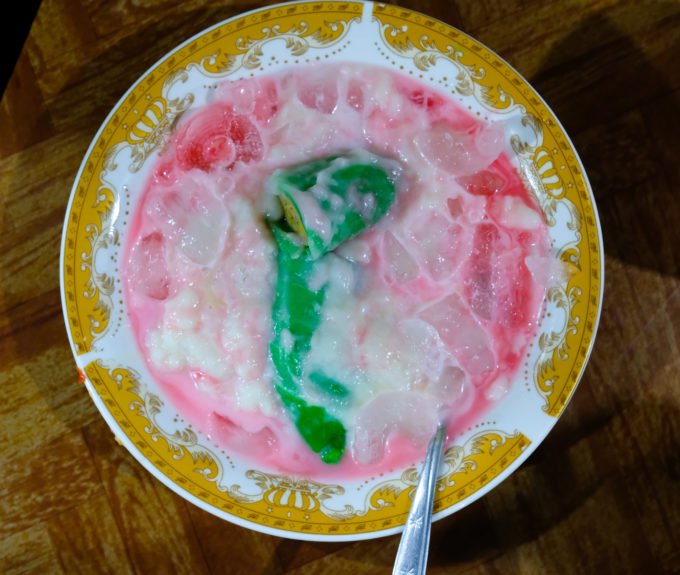
Never Ask Permission to Have Dessert for Breakfast

Never Ask Permission to Have Dessert for Breakfast
Iced Green Banana in Sulawesi
“Is it OK to have it for breakfast?” I asked my host, Nazar.
It was a rainy morning in Makassar, the capital of Sulawesi, where rice and noodles are the staple dish, several times a day. I felt that I needed to ask permission to indulge my sweet tooth by eating a local treat—the green banana—this early in the day.
Nazar, seated on the opposite side of the table, gave me the nod. “Sure. You can have it whenever you like.”
I had heard a lot about this Indonesian green banana. When the dish was finally placed before me on the plastic table and I had a better look, it looked like an abstract painting: an acid-green banana floating on a thick, custard-like white sauce, slowly sinking into a plateful of fluorescent pink syrup.
Amused, Nazar watched and waited for me to make my move, but where to begin? The waiter had placed a small bucket filled with ground ice at the side of my plate, without explaining what to do with it.
“Mix them together,” Nazar said, perhaps a touch annoyed by my unfamiliarity with one of his city’s famous dishes. “Pour the ice on top, and mix it.”
After I added the ice, the white custard started to melt and absorb the syrup, almost submerging the banana.
I carefully pushed my spoon into the banana’s outer layer, cracking it, and then dunked a chunk into the syrupy mixture. Sweet goodness.
Es Pisang Ijo, iced green banana, is a traditional sweet dish among the Bugis, one of Sulawesi’s ethnic groups. Like building Phinisi boats—the traditional, schooner-like wooden vessels used by the seafaring communities of the Malay archipelago—it’s a Makassar specialty.
The broth is made with coconut milk, suji, and pandan leaves mixed with rice flour, sugar, and a pinch of salt. The banana is green because, after being steamed, it’s rolled into layers of pandan leaves, oil, and flour dough. When cooked slowly, this outside layer solidifies around the banana, creating a thick, green, waxy coating that seals the fruit inside a layer of sweetness.
“How is it?” Nazar asked. He had been observing me from his side of the table, hunched behind his cup of steaming tea, studying the movements of my spoon as I cut into the green crust. When only half the banana remained in the middle of a watered-down pink broth, Nazar raised his elbows from the table and sank back into his chair.
Like a real Makassarese, he ordered the rice and egg instead.